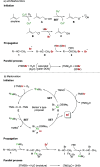Iron(II) and Copper(I) Control the Total Regioselectivity in the Hydrobromination of Alkenes
- PMID: 34318671
- PMCID: PMC8397429
- DOI: 10.1021/acs.orglett.1c02186
Iron(II) and Copper(I) Control the Total Regioselectivity in the Hydrobromination of Alkenes
Abstract
A new method that allows the complete control of the regioselectivity of the hydrobromination reaction of alkenes is described. Herein, we report a radical procedure with TMSBr and oxygen as common reagents, where the formation of the anti-Markovnikov product occurs in the presence of parts per million amounts of the Cu(I) species and the formation of the Markovnikov product occurs in the presence of 30 mol % iron(II) bromide. Density functional theory calculations combined with Fukui's radical susceptibilities support the obtained results.
Conflict of interest statement
The authors declare no competing financial interest.
Figures





References
-
- Dewick P. M.Medicinal Natural Products: A Biosynthetic Approach, 2nd ed.; John Wiley & Sons, 2002.
-
- Metathesis in Natural Product Synthesis: Strategies, Substrates and Catalysts; Cossy J., Arseniyadis S., Meyer C., Eds.; John Wiley & Sons, 2011.
-
- Astruc D.Organometallic Chemistry and Catalysis; Springer, 2007.
-
- De la Mare P. B. D.; Bolton R.. Electrophilic Additions to Unsaturated Systems, 2nd ed.; Elsevier, 1982.
Publication types
LinkOut - more resources
Full Text Sources

